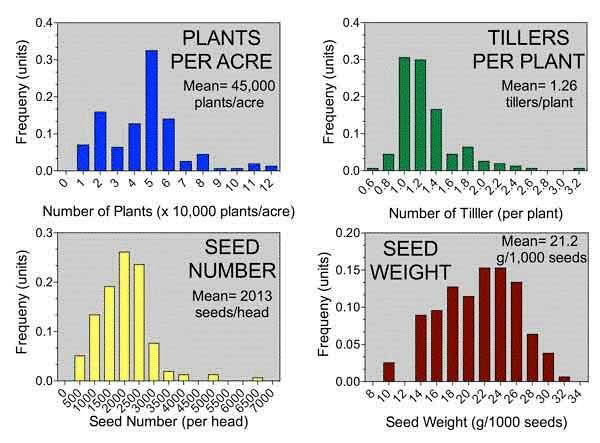In order to best estimate the yield potential of grain sorghum, we need to understand the main plant components of sorghum yield. The main yield-driving factors are:
- number of plants,
- number of tillers per plant,
- total number of seeds per head, and
- seeds per pound.
The number of plants and the number of tillers per plant are two of the main components and are determined well before the end of the growing season. The initial plant density, planting date, and the environment, among other factors, influence those two yield components. To learn more about an on-farm approach for calculating sorghum grain yield potential before harvest, please see the companion eUpdate article in this issue, “Grain sorghum yield potential: An on-farm calculation”.
Understanding sorghum yield components
Increasing the number of plants per acre potentially increases competition for resources, which can diminish the plant’s capacity to produce tillers. In addition, the interaction of planting date with plant density can have a similar effect. As planting date is delayed, the capacity of the plant to produce tillers will be reduced; thus, plant population needs to be increased to compensate for the reduction in the number of tillers. Previous research at K-State showed sorghum produces more tillers when planted early (mid-to-late May) at lower plant populations as compared with late planting dates (mid-to-late June).
The environment also plays an important role in the final number of heads per unit area. Heat and drought stress will reduce the plant’s ability to produce more tillers and could severely reduce the tiller survival rate. The total number of seeds per head will be determined within the one- or two-week period before flowering until milk to soft dough stages (approximately two to three weeks after flowering).
Seed size will be determined close to the end of the season. In the 15 to 25 days after flowering, during the soft dough stage, sorghum grains have already accumulated about 50% of the final dry mass. Thus, the period around flowering is critical for defining not only the final number of grains per head but also the potential maximum kernel size. Final seed weight will be determined when the grains reach physiological maturity (visualized as a “black-layer” near the seed base). From this time until harvest, the grains will dry down from approximately 35% to 20% moisture content.
The interaction among all four components will determine the actual yield, but a wide range of variation can be expected in all these main yield-driving forces (Figure 1).

Figure 1. Example of the variation expected to be found in the main sorghum yield components. The number of tillers per plant can also be interpreted as the number of heads per plant, considering that all tillers have one fertile head.
Seed number is the main driving force of sorghum yield. Actual seed counts per head would make the estimates more accurate but requires considerable time and effort.
Ignacio A. Ciampitti, Farming Systems
ciampitti@ksu.edu